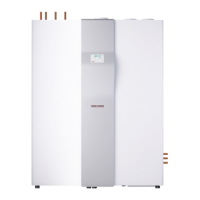10
4.4 Electrical installation
Permission must be obtained from your local power supply utility.
WARNING Electrocution
Carry out all electrical connection and installation work
in accordance with national and regional regulations.
WARNING Electrocution
The appliance contains inverters (e.g. variable speed
compressors, high efficiency circulation pumps or high
efficiency fans). In the event of a fault, inverters can
cause DC residual currents. If RCDs are provided, they
have to be type B AC/DC-sensitive.
A DC residual current can block type A RCDs.
Ensure that the appliance power supply is discon-
nected from the distribution board.
Electrical data is provided in the chapter „Specification/ Data
table“.
All electrical connection and installation work must be carried out
in accordance with VDE regulations (DIN VDE 0100) [or local regu-
lations], the rules of your local power supply utility, and relevant
national and local regulations.
The cable cross-section must be designed for the maximum pos-
sible operating current of the appliance (see „Specification/Data
table“).
Note
Route the power cables and control cables separately.
Note
Provide separate fuses for the power circuits for the ap-
pliance, the electric emergency/booster heater and the
control unit.
4.5 Oxygen diffusion
!
Material losses
Do not use open vented heating systems. Use oxygen
diffusion-proof pipes in underfloor heating systems with
plastic pipework.
In underfloor heating systems containing permeable plastic pipes,
or in open vented heating systems, oxygen diffusion can cause
corrosion to the steel components of the indirect coil in the DHW
cylinder, steel radiators or steel pipes.
!
Material losses
The products of corrosion (e.g. rusty sludge) can sett-
le in the heating system components, which may result
in a lower output or fault shutdowns due to reduced
cross-sections.
4.6 Transport
!
Material losses
If the appliance is transported without packing and wit-
hout using a pallet, its outer casing may be damaged.
Remove the side panels and doors in such cases.
4.6.1 Function module
To protect the appliance against damage, transport it vertically
inside its packaging. Where space is restricted, you can also tilt
the appliance at an angle to move it.
To make handling easier, you may attach a transport aid on the
back of the function module. This comprises two angled brackets.
Fit one angle bracket each vertically on the l.h. and r.h. side.
26_04_01_0620_
1
1 Transport aid
Slide a robust pipe through the holes inside the transport
aids to create a handle.
The transport aid can also be used in connection with a
crane/hoist to transport the appliance to the installation
location.
4.6.2 Cylinder module
!
Material losses
During transport, never hold the cylinder module by its
connection pipes, as these would bend out of shape.
Note
We recommend the transport of the cylinder module on
its pallet to the installation location. The pallet offers
more places to hold than the cylinder module casing.
There are two grip recesses at the top of the back panel.
1
D0000075609
1 Recessed grips

